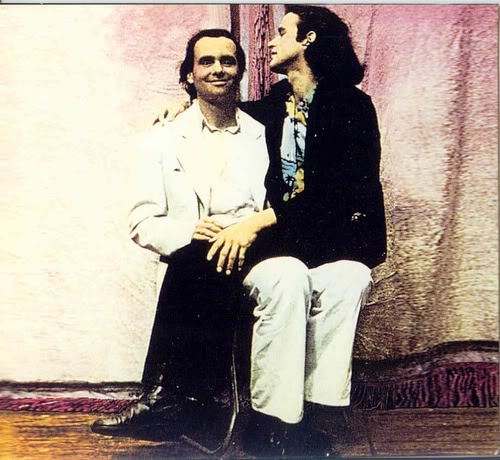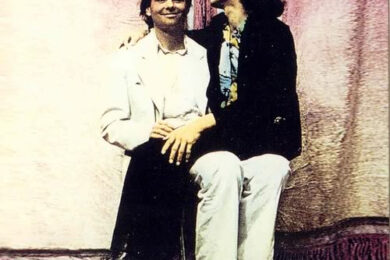If "Massively Influential Band Reforms" isn’t the headline it used to be, then that’s in no way the fault of Hans-Joachim Roedelius and Dieter Moebius. In 2007 the understated electro-ambient godfathers revived not one, but two hallowed names of Krautrock in the shapes of Cluster and Harmonia, their team-up with Neu!’s Michael Rother. But in parallel with their patient, tangential music, Roedelius and Moebius’s history since meeting in Berlin’s Zodiak Free Arts Lab at the close of the 1960s has been one not of abrupt splits and reunions, but of steady alliance and continual reconfiguration, weaving Cluster, Harmonia and casually era-defining encounters with the likes of Brian Eno around their tandem, and prolific, solo careers.
Newly released in the UK, Cluster’s latest album Qua takes the opposite tack to 1995’s extended improvisation One Hour, with 17 bite-sized songs, many of which sneak playfully under the two-minute mark. They’re unmistakably the work of Cluster, however, manipulating space and a subtle sense of intrigue in ways both as straightforward and as cryptic as the pair themselves remain.
The Quietus caught up with Roedelius and Moebius a few weeks ago as the pair were preparing for a UK tour, including a date at Sunderland Aquatic Centre where swimsuit-clad fans got the chance to experience simultaneous underwater and above-the-surface mixes of the duo’s set.
What are your thoughts on making your sub-aquatic debut?
Hans-Joachim Roedelius: We played in the North Sea at low tide; we played in forests, on fields, in gardens, parks, warehouses, schools, universities, on streets, in discos, clubs, big concert halls, cathedrals, on mountains, on lakes, in bedrooms, galleries, art-halls and museums. Why not do a music that will be mixed for underwater listening?
Why was it time to make another Cluster album and what was different this time around?
Dieter Moebius: The last studio album was made so long ago; we did not want to only release live albums. Of course in the mid-90s, it would not have been the same music: other instruments and younger musicians.
HJR: After that long break between our last studio album One Hour and Qua, it was a super-challenge as well as great fun to work in a studio again, especially with our colleague Tim Story, who did, as Conny Plank did in the past, a great job on the production.
I think what was different production-wise was that we were able to work with the advanced technology that is available nowadays, and Tim’s great understanding of what Cluster did in the past. I have already done three albums with Tim and he has worked on the sound for me on several occasions and played live with me around the globe.
Qua packs 17 tracks into less space than One Hour used for a single one. What virtue is there in brevity?
HJR: It shows what Cluster always was keen to show: a certain kind of humour and flexibility regarding form and sound-quality, as just ‘Clustermusic’.
The instrumental and technological possibilities available to Cluster today are a world away from the synths and early drum machines of the early 1970s. Do you deliberately try to restrict your sonic palette?
HJR: Yes, we both restrict ourselves to a certain quality and amount of sonic tools as an aid for our creativity. We work with pre-prepared sound materials from CD-Rs, with Kaoss Pads and small keyboards. But with all that in mind, what our experience throughout our career brought to us is an awareness of what we have to do when we’re playing live, in which way it works best.
DM: I work with a Korg microsampler, a Roland sampler, Kaoss Pads and Korg MicroX. I think that’s restricted enough. I am not working with software.
After four decades, what quality do you most admire in the other member of Cluster?
HJR: Moebius is the most noble person I ever met in my life and he is a real dear friend.
DM: Achim is a great melody-maker; the rest is very private.
What advice would you offer to yourselves as musicians in 1971? And what do you think your younger selves would say to you today
HJR: To approach and do art and music the way I did and do, just by heart. But in my case it’s also something that is in my blood from my ancestors who were preachers, cantors and teachers. So I’m an exception, it’s not comparable what I do to what most other artists do. I’m doing art in the way of writing a musical diary and my poetry is absolutely personal.
DM: In ’71 the advice to me would have been to be a little more serious about the output. My younger myself would tell me today to not be so serious about it.
Can you imagine a version of Cluster where you never moved to Forst?
HJR: Not at all, Cluster without Forst is unthinkable. Being forced to live the rural life with hard work to survive; picking wood in the forests to be able to have it warm in wintertime in front of the open chimneys; making our own bread, cooking, gardening, being surrounded by animals such as horses and cows, chickens and geese and such, this was – at least for me – absolutely essential to become aware of my own destination in the so-called reality.
DM: Of course Forst surely had some kind of influence on our output; but since I worked a lot in Conny’s studio, I could imagine that my music would be quite similar without Forst.
For a long time the impact of a record such as Sowiesoso was measurable less in terms of recognition for yourselves and more as ripples spreading through a succession of artists inspired by it. Did you realise how influential you were at the time?
HJR: All that we did during our career, we did with great respect, interest and fun. We weren’t much aware of the fact that we were pioneers, in the way of thinking, "Oh, this is avant-garde, what we’re doing, great artwork", or such. It was our profession from the beginning to just do it.
DM: No, I had no idea of influencing anybody. But also I think this effect occurred later, I mean that Sowiesoso influenced other musicians only many years later.
Do you feel that any of your records have been overlooked?
DM: Yes, lots of albums have been overlooked. In my case it was the Ersatz albums [with Karl Renziehausen] and also Blotch and Nurton, but they will be re-released. Blotch just came out in the USA.
HJR: At the time when we did it, the public wasn’t aware of the quality of the so-called electronic music, they had to learn whether they liked it or not. Most didn’t like it in the first moment, so the Clustermusic couldn’t make into the appreciation of a big crowd in those early days.
Now, two generations later, people realize the strength and beauty of our music. Fortunately we’re still alive and able to earn the fruit of what we sow.
Are there any artists you remember from your Zodiak Free Arts Lab days who you wish were better known now?
HJR: Oh yes, Boris – Horst Rainer – Schaak for example, one of the most talented in the group of inventors at the field of arts and music in Berlin at the time. Or Verena Tschürtz, who is a painter in Berlin, Elke Lixfeld, Christoph Sievernich, Broderick Price: they all deserve great respect for their input into the arts at the time and nowadays.
What still surprises you about being in Cluster?
DM: It’s surprising to have a young audience after all that time!
HJR: That I’m still with Moebius after more than 40 years, that we love what we do, that we have such great fun to work together and visit each other sometimes privately outside the work we’re doing. Viva la vida, viva amor e viva Cluster.
Qua is available on Nepenthe now. Sowiesoso and Curiosum are both available via Bureau B



